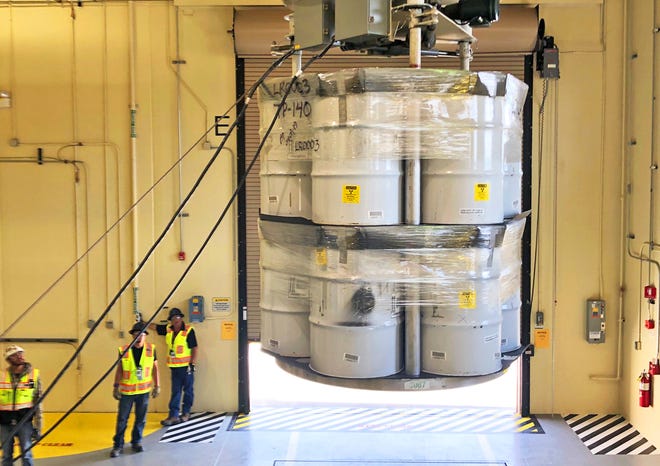An alleged failure to clean up hazardous and radioactive waste at Los Alamos National Laboratory (LANL) led the New Mexico Environment Department (NMED) to take the U.S. Department of Energy (DOE) to court in hopes of seeing the DOE address its concerns.
In a complaint filed in the First Judicial District Court in Santa Fe County, NMED alleged the DOE displayed a “pattern” of failing to meet deadlines and benchmarks for hazardous waste clean-up at the federal nuclear facility in northern New Mexico.
NMED sought to terminate a 2016 consent order, enacted during the past administration, citing a lack of adequate targets and progress in cleaning up waste at the facility.
More:Waste Isolation Pilot Plant: Nuclear waste shipments reduced, projects delayed amid COVID-19
The order expired on Jan. 22, 2021.
NMED also sought a civil penalty of $333,000 and called for court-supervised negotiations to set proper targets and a schedule to address contamination.
The Department attempted to mediate these issues with LANL and the DOE in October 2020, per an NMED news release, but was unable to agree on a plan.
Waste at LANL was generated through ongoing operations such as nuclear weapon design and testing, explosives research, development, and fabrication and chemical research.
More:New Mexico senator renews push for more state oversight of nuclear projects
The facility also conducts electrical research, laser design and photographic testing.
NMED Cabinet Secretary James Kenney said the DOE failed to meet the terms and expectations of the State that waste streams contaminating the environment from LANL’s operations would be cleaned up in a timely manner.
“Today, we are seeking to terminate the 2016 Consent Order and initiate court-supervised negotiations to renegotiate clean-up terms that protect communities and their environment,” said NMED Cabinet Secretary James Kenney upon announcing the complaint.
“The Department entered the 2016 Consent Order with high expectations, but almost five years later, our expectations are far from met.”
More:What did the U.S. Department of Energy achieve at New Mexico nuclear sites in 2020?
Sources at LANL and the DOE did not provide a response to inquiries from the Current-Argus, despite numerous attempts to contact them.

Years of alleged failure to clean up nuclear waste
The LANL facility, located on about 36 square miles on the Pajarito Plateau in Los Alamos County sits on an area dissected by 19 surface drainages or canyons that drain into the Rio Grande which runs along the facility’s eastern border.
From its operations since opening in 1943, LANL generated numerous waste streams which were treated, stored or disposed of at the site.
More:Plan to send diluted plutonium to Waste Isolation Pilot Plant moves forward
Management of the waste resulted in the release of hazardous materials, contaminating groundwater, the complaint read, which remains in the environment at the facility to this day.
These wastes were disposed of in septic systems, pits, impoundments, trenches, shafts, landfills and waste piles at the lab, the complaint read.
LANL and the DOE notified the U.S. Environmental Protection Agency of its hazardous waste activity in 1980, identifying 129 waste streams.
More:What does the Waste Isolation Pilot Plant hope to achieve during 2-month outage?
The EPA authorized the State of New Mexico to conduct a hazardous waste program in 1985 under state law aimed at mitigating the pollution without a federal program in place.

New Mexico state law under the Hazardous Waste Act identified hazardous waste – what was identified as having been released at LANL – as waste causing increased death or illness in people or posing hazard to human health if left untreated, stored or disposed.
By 2002 after several revisions to the LANL hazardous waste program, NMED had issued a determination that LANL had continued to pose a risk to human health through its hazardous waste management.
More:Holtec aims for manufacturing site in Carlsbad for nuclear waste project, add 150 jobs
“The Determination found that the past or current handling, storage, treatment, or disposal of any solid waste or any hazardous waste may present an imminent and substantial endangerment to health or the environment based on the documentation of waste handling and disposal practices at the facility, analytical results from soil, sediment, surface water and groundwater sampling, and other documented information,” read NMED’s complaint.
The first compliance order between NMED and federal government was entered in 2005, leading to NMED withdrawing its 2002 determination and subsequent orders against LANL.
Per the recent complaint, by 2012, LANL and the DOE had made a “pattern of requesting extensions” for deadlines under the 2005 agreement.
More:WIPP: Test of fan that could be contaminated with radiation completed. Results forthcoming
A revised consent order was drafted in 2016, viewed as controversial, the complaint read, for a lack of compliance incentives or completion deadlines outlined in the 2005 order.
The order was to be funded by Congress, and the DOE submitted revisions through the years based on its appropriated budget, but NMED found revisions for Fiscal Year 2021 “insufficient,” read the complaint, as they would mean cleanup would extend beyond the final deadline of 2036.
“NMED will vigorously pursue this matter to ensure timely clean-up of legacy contamination that New Mexicans deserve through a comprehensive, expeditious and enforceable clean-up plan at LANL,” read a statement from the NMED.
More:Texas Gov. Greg Abbott objects to nuclear waste facility proposed in Permian Basin
Don Hancock, director of the nuclear waste program at the Southwest Research and Information Center – a government and environmental watchdog group based in Albuquerque said the DOE was granted more than enough leeway in the 2005 and 2016 consent orders and court action was needed to make the DOE comply.
“I think the complaint is well taken in the sense that DOE got a sweetheart deal from the previous NMED on the consent order and they’re not even fully complying with that,” he said. “That’s significant. When someone isn’t doing what they’re supposed to do, what recourse does NMED have. Their only recourse is to go to court.”
Hancock said he hoped the federal government would seek to mitigate the situation quickly without wasting taxpayer dollars in a lengthy court dispute.
“I’m glad that NMED went to court. If LANL is serious, they should not be spending lots of federal time and resources and lawyers to fight this,” he said. “They should be trying to see what they can do to come to an agreement with NMED.”
Adrian Hedden can be reached at 575-618-7631, achedden@currentargus.com or @AdrianHedden on Twitter.






